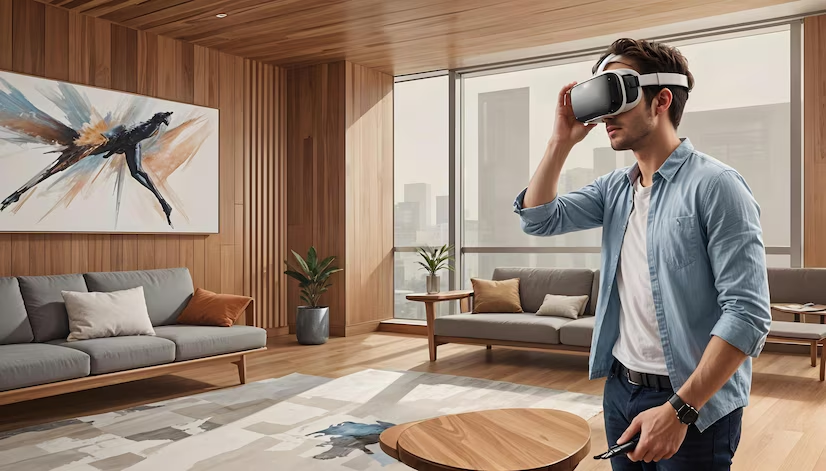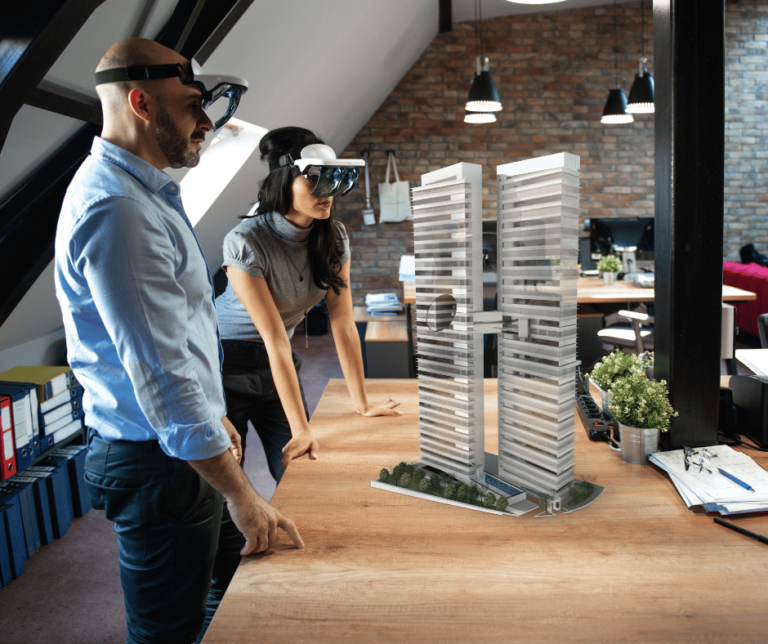E-commerce has become a major player in the retail industry, with projected global sales of 657.8 billion by 2029 according to Statsita. The need for improved, immersive shopping experiences has increased as more people buy online for convenience, variety, and affordable prices. Presenting Augmented Reality (AR), a game-changing technology that has the potential to completely change the e-commerce industry. Through the merging of the virtual and real worlds, augmented reality (AR) provides customers with a distinct, engaging experience, closing the gap between online and in-store purchases. This article will discuss how augmented reality (AR) is affecting e-commerce, how it improves the buying experience, and why companies should think about implementing this technology to remain competitive.
The Use of Augmented Reality in Online Shopping
The use of augmented reality has expanded quickly in a number of sectors, including gaming, entertainment, healthcare, and education. On e-commerce, though, its influence has been especially significant. Over 70% of businesses will have experimented with immersive technologies by 2023, and 25% will have implemented them in production, according to a Gartner analysis. Because augmented reality (AR) can be used to create individualized and interesting shopping experiences that increase customer satisfaction and conversions, the e-commerce industry has embraced AR in particular.

What is Augmented Reality?
With the use of a gadget like AR glasses or a smartphone, users can overlay digital content—such as sounds, images, or data—onto the physical world. This technology is known as augmented reality. Augmented Reality (AR) improves the actual world by incorporating digital features that users may interact with in real time, in contrast to Virtual Reality (VR), which submerges people in a fully digital environment. With the capacity to help shoppers see things in their surroundings before making a purchase, augmented reality (AR) is a potent tool for e-commerce.
Enhancing the Shopping Experience with AR
1. Virtual Try-Ons: The Future of Fashion Retail
Trying on clothes, shoes, or accessories before making a purchase is one of the biggest obstacles in online fashion retail. This restriction frequently results in ambiguity, increased return rates, and disgruntled customers. In order to solve this problem, augmented reality (AR) offers virtual try-on, which lets users see how items appear on them instantly.
Apps with AR capabilities, for example, allow users to try on shoes, clothing, and makeup from the comfort of their own homes. Companies such as Sephora and Warby Parker have effectively integrated augmented reality to enable customers to virtually test on makeup hues or eyewear. A research by Accenture found that 61% of customers choose stores who provide augmented reality experiences. When a product is available for virtual reality (AR), 40% of consumers are willing to pay extra for it.
2. Interactive Product Visualization: Bringing Products to Life
Trying on clothes, shoes, or accessories before making a purchase is one of the biggest obstacles in online fashion retail. This restriction frequently results in ambiguity, increased return rates, and disgruntled customers. In order to solve this problem, augmented reality (AR) offers virtual try-on, which lets users see how items appear on them instantly.
Apps with AR capabilities, for example, allow users to try on shoes, clothing, and makeup from the comfort of their own homes. Companies such as Sephora and Warby Parker have effectively integrated augmented reality to enable customers to virtually test on makeup hues or eyewear. A research by Accenture found that 61% of customers choose stores who provide augmented reality experiences. When a product is available for virtual reality (AR), 40% of consumers are willing to pay extra for it.
3. Personalization and Customization: Tailoring the Shopping Experience
In e-commerce, personalization is a major factor in determining client satisfaction. By enabling consumers to alter things in real time and experience the results right away, augmented reality (AR) has the potential to revolutionize personalization. Customers can utilize augmented reality (AR) to customize footwear, jewelry, and even cars by altering features, colors, and materials prior to placing an order. This degree of personalization not only improves the user experience but also helps the customer and the business develop a stronger emotional bond. A Deloitte poll found that 36% of consumers were interested in buying personalized products. Augmented reality (AR) can make this procedure more simple and entertaining.
4. Augmented Shopping Assistance: Virtual Guides and Tutorials
Purchasing sophisticated goods, like electronics or household appliances, may be somewhat daunting for buyers. As clients browse products, augmented reality (AR) can serve as a virtual shopping assistant, offering them real-time information, tutorials, and guides. AR can, for instance, overlay detailed usage instructions for a product, contrast several models, or draw attention to important details. In addition to enhancing the shopping experience, this kind of enhanced support lowers the possibility of returns and post-purchase remorse. In fact, according to a PTC survey, 68% of consumers said they would be more likely to buy a product if augmented reality (AR) helped them make a decision.
The Impact of AR on E-commerce Metrics
Advantages of integrating augmented reality (AR) into e-commerce platforms have been observed for a number of key performance indicators (KPIs) that are essential to the success of a business. Some of the most important KPIs that AR has an impact on are listed below.
1. Increased Conversion Rates
As previously indicated, by giving customers a more immersive and secure buying experience, augmented reality (AR) can dramatically increase conversion rates. Customers are more likely to finish a purchase when they can digitally try on a product or see it in their surroundings. Brands who used augmented reality (AR) witnessed an average 40% increase in conversion rates, per a Vertebrae analysis.
2. Reduced Return Rates
The high percentage of product returns is one of the main problems for online merchants. AR can lessen this problem by giving consumers the ability to make better-informed purchasing decisions. Customers are less likely to return a product when they have a better idea of how it will fit, look, and work in their life. Shopify discovered that AR experiences decreased product returns by 22%.
3. Enhanced Customer Engagement
Increased client engagement is a natural result of augmented reality’s interactive nature. When a product can be realistically tried on or interacted with in three dimensions, shoppers are more inclined to spend time investigating it. Higher levels of client satisfaction and loyalty are frequently the result of this enhanced interaction. According to a Nielsen survey, augmented reality experiences can keep users’ attention for up to 85 seconds—much longer than traditional media.
4. Higher Average Order Value (AOV)
By enticing clients to investigate more features or items, augmented reality (AR) can help increase average order values. For example, a consumer trying on shoes with augmented reality would also be encouraged to look into complementary accessories, which could result in an upsell. A 20% boost in AOV was attributed to AR encounters, according to the same Vertebrae study.
Challenges and Considerations for Implementing AR in E-commerce
While the benefits of AR in e-commerce are clear, businesses must also consider the challenges and best practices for successful implementation.
1. Technical Requirements and Integration
AR implementation in e-commerce necessitates a certain degree of infrastructure and technical know-how. Companies must make sure that, without sacrificing functionality, their websites or apps can enable augmented reality interactions. To guarantee a flawless user experience, this may entail making investments in 3D modeling, AR software development, and testing. Furthermore, it is essential to integrate with current e-commerce platforms and processes. Regardless of the channel—desktop, smartphone, or physical store—the augmented reality experience ought to be uniform across all users. This process can be streamlined by utilizing AR development platforms and collaborating with knowledgeable AR developers.
2. User Accessibility and Adoption
Even though augmented reality technology is now more widely available, not all customers are at ease or knowledgeable about utilizing it. In order to guarantee that customers can comprehend and navigate AR experiences with ease, businesses must take user education and onboarding into account. To close the gap and promote adoption, provide clear instructions, tutorials, or even in-app guidelines.
To reach the largest audience possible, businesses need also make sure that their augmented reality experiences work with a variety of hardware and operating systems. A lack of awareness or comprehension of augmented reality was highlighted by 32% of consumers as a hurdle to adoption, per a poll conducted by ARtillery Intelligence.
3. Privacy and Data Security
When integrating AR into e-commerce, privacy and data security are crucial factors to take into account, just like with other digital technology. Access to a user’s camera, location, and other private information is frequently needed for AR experiences. It is imperative for businesses to implement strong data protection protocols to secure client data and adhere to pertinent privacy laws. Openness is also essential. Before collecting any consumer data, businesses should get consent and disclose how the data will be used. Establishing credibility with consumers is critical to AR’s long-term viability in e-commerce.
The Future of AR in E-commerce
The future of AR in e-commerce looks promising, with continued advancements in technology and increased consumer demand for immersive experiences. Here are some trends to watch:
1. Expansion of AR into New Product Categories
Even though AR has already had a big impact on the fashion, furniture, and cosmetics industries, more product categories are anticipated to see its expansion in the years to come. AR is expected to be used more often in the real estate, automotive, and healthcare industries for consumer engagement, training, and product visualization.
2. Integration with AI and Machine Learning
Artificial intelligence (AI), machine learning, and augmented reality (AR) will open up new possibilities for tailored and anticipatory purchasing experiences. To further improve the shopping experience, AI might, for instance, examine a customer’s preferences and behavior to recommend augmented reality activities that are specific to their interests.

